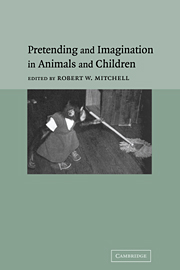Book contents
- Frontmatter
- Contents
- List of contributors
- Foreword by Sue Taylor Parker
- Preface and acknowledgments
- I Historical, developmental, and comparative overviews
- II Pretense and imagination in children
- 4 Language in pretense during the second year: what it can tell us about “pretending” in pretense and the “know-how” about the mind
- 5 A longitudinal and cross-sectional study of the emergence of the symbolic function in children between 15 and 19 months of age: pretend play, object permanence understanding, and self-recognition
- 6 Caregiver-child social pretend play: what transpires?
- 7 Just through the looking glass: children's understanding of pretense
- 8 Young children's understanding of pretense and other fictional mental states
- 9 Pretend play, metarepresentation and theory of mind
- 10 Replica toys, stories, and a functional theory of mind
- 11 Young children's animal-role pretend
- 12 Imaginary companions and elaborate fantasy in childhood: discontinuity with nonhuman animals
- III Pretense and imagination in primates
- IV Prospects
- References
- Author Index
- Subject Index
7 - Just through the looking glass: children's understanding of pretense
Published online by Cambridge University Press: 13 August 2009
- Frontmatter
- Contents
- List of contributors
- Foreword by Sue Taylor Parker
- Preface and acknowledgments
- I Historical, developmental, and comparative overviews
- II Pretense and imagination in children
- 4 Language in pretense during the second year: what it can tell us about “pretending” in pretense and the “know-how” about the mind
- 5 A longitudinal and cross-sectional study of the emergence of the symbolic function in children between 15 and 19 months of age: pretend play, object permanence understanding, and self-recognition
- 6 Caregiver-child social pretend play: what transpires?
- 7 Just through the looking glass: children's understanding of pretense
- 8 Young children's understanding of pretense and other fictional mental states
- 9 Pretend play, metarepresentation and theory of mind
- 10 Replica toys, stories, and a functional theory of mind
- 11 Young children's animal-role pretend
- 12 Imaginary companions and elaborate fantasy in childhood: discontinuity with nonhuman animals
- III Pretense and imagination in primates
- IV Prospects
- References
- Author Index
- Subject Index
Summary
“When I use a word,” Humpty Dumpty said in a rather scornful tone, “it means just what I choose it to mean-neither more nor less.”
“The question is,” said Alice, “whether you can make words mean so many different things.”
“The question is,” said Humpty Dumpty, “which is to be master-that's all.”
(carroll, 1871/1946, p. 238)Alice's world through the looking glass, though actually a world of dream, is in some respects like the world of pretend. Just as Humpty-Dumpty can be master of words, making them mean what he wants them to mean, in pretend play children designate what various objects and activities denote. Pretending is a special frame that organizes the activities within it. What goes on in the frame has its own reality, stipulated as the players choose, such that a behavior acted while pretending may have alternative significance while not pretending (Bateson, 1955/1972). This impressive ability to deal in framed worlds is fundamental to pretense (Fein, 1981; Bretherton, 1984). Framing also appears fundamental to other human activities, such as reflecting on dreams and understanding others' minds. Like pretense, another's mental world is framed by that person's prespective. When children learn to pretend, they learn to deal with worlds that are framed differently from the real world. In the looking glass world, nursery rhyme characters come to life, words mean anything you want, and memory can work both backwards and forwards.
The pretend world is not entirely unconstrained.
- Type
- Chapter
- Information
- Pretending and Imagination in Animals and Children , pp. 102 - 114Publisher: Cambridge University PressPrint publication year: 2002
- 10
- Cited by



